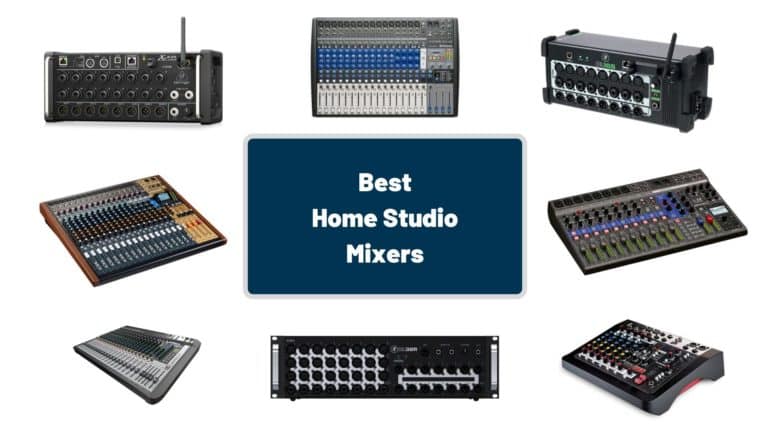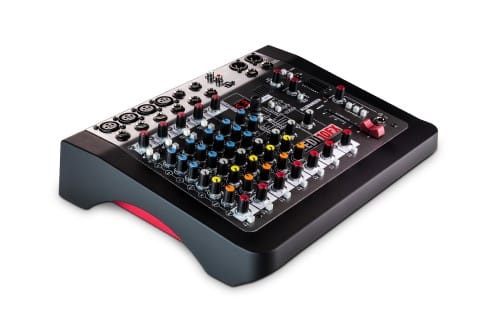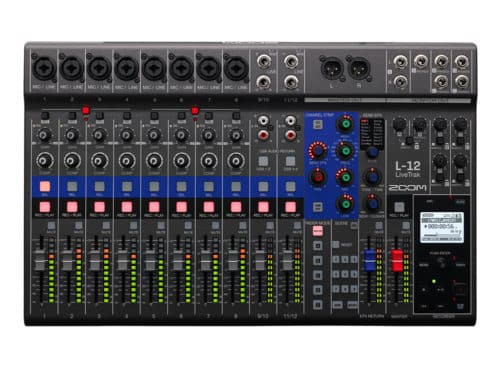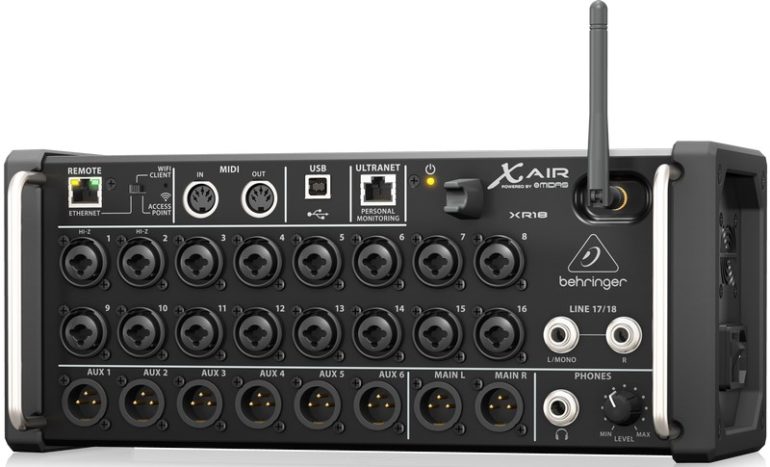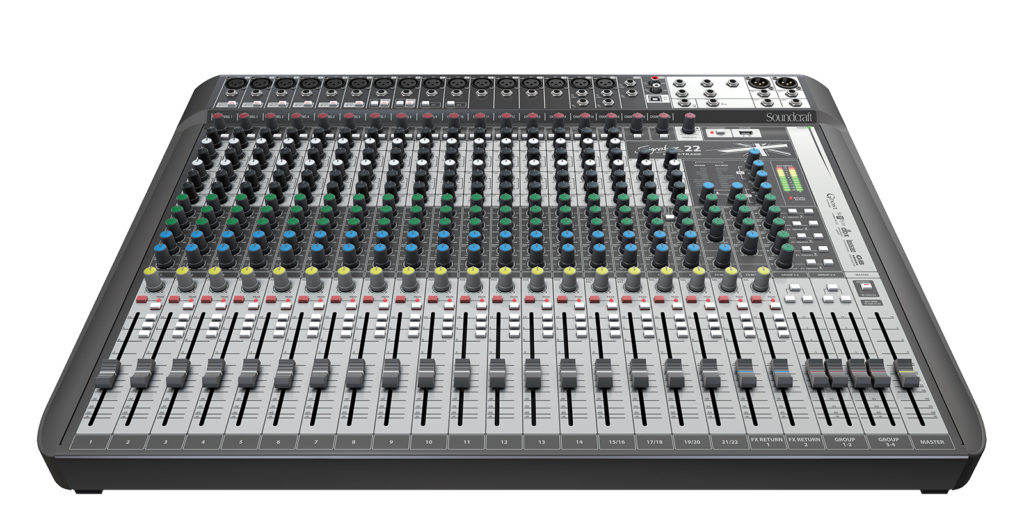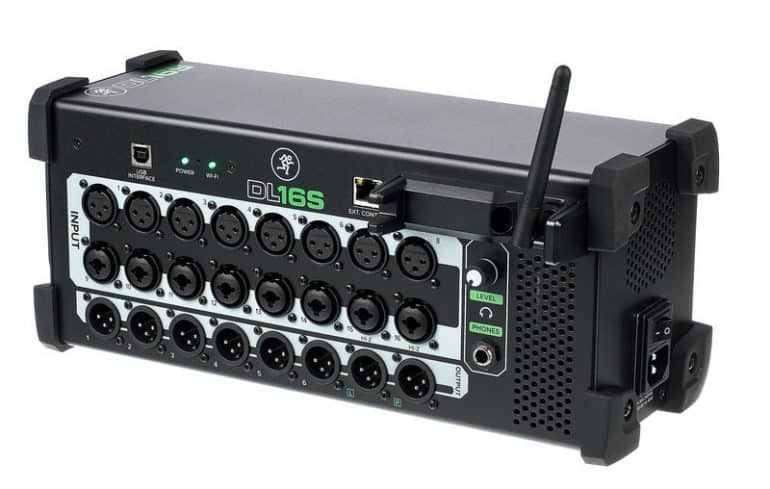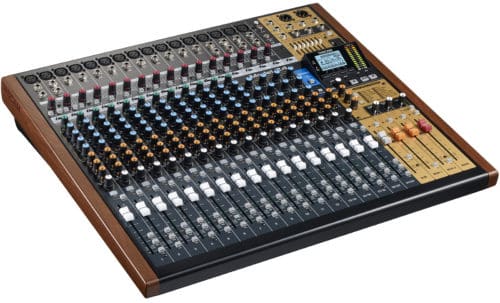Last updated on December 31st, 2023 at 09:29 pm
Finding good mixers for your home studio can be quite a challenge, especially if you’re looking for ones that can do some multi-track recording since most “USB” mixers can’t really multi-track.
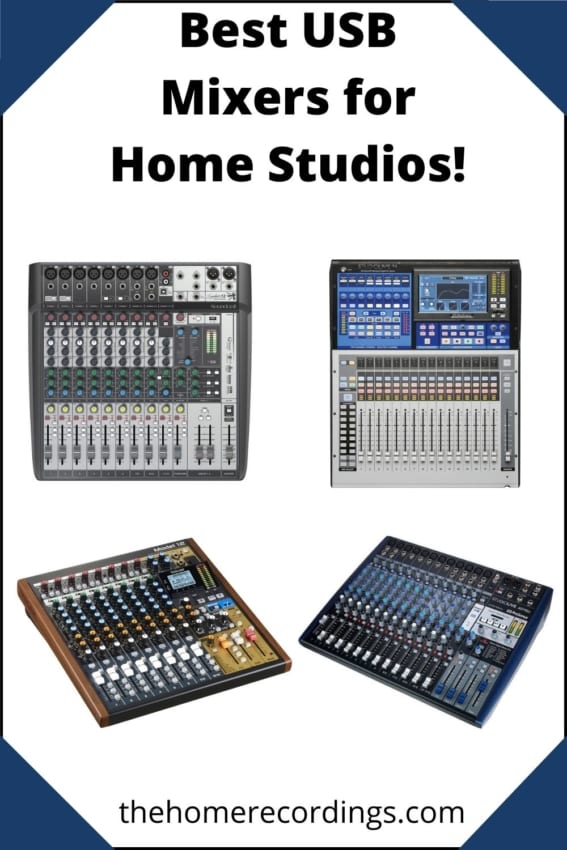
In this article I’m going to list the best mixers for any home- and even professional studio, that can even be used for live performances and that are capable of doing multitrack recordings.
Note: They will be listed from cheapest to most expensive.
Best 5 USB Mixers for Home Studios
| Mixer | Inputs | Outputs | Free Software | A/D Resolution | Wireless | Motorized Faders | Record to SD | DAW Control |
|---|---|---|---|---|---|---|---|---|
| Allen & Heath ZEDi 10FX | 4x XLR/TRS | 2x XLR (Main) 1x TRS Aux 1x TRS FX 1x Headphone | Cubase LE & Cubasis LE | 24-bit/96kHz | No | No | No | No |
| StudioLive Arc8 | 4 x XLR 1 x Dual RCA Stereo, 1 x 1/8″ 4 x 1/4″ 2 x 1/4″ (Hi-Z/line) | 2 x XLR (main) 2 x 1/4″ TRS 1x Headphone 1x 1/4″Aux 1x 1/4″ FX | Studio One Artist Capture Live Studio Magic Plugin Suite | 24-bit/96kHz | No | No | Yes | No |
| Zoom LiveTrak L-12 | 8 x XLR-1/4″ combo 4 x 1/4″ 2 x Dual RCA 2 x XLR-1/4″ (hi-Z) | 2 x XLR (Main) 2 x 1/4″ 5 x Monitor 5 x Headphone | None | 24-bit/96kHz | No | No | Yes | No |
| Soundcraft Signature MTK 12 | 8 x XLR 10 x TRS 1 x Stereo (RCA) | 2 x XLR 3 x TRS (Aux) 2 x subgroup 1 x Footswitch 1 x Headphone | Ableton Live Lite Lexicon MPX-L | 24-bit/48kHz | No | No | Yes | No |
| Tascam Model 12 | 8 x XLR-1/4″ combo 1 x 1/8″ 2 x 1/4″ | 2 x XLR 2 x 1/4″ 2 x Headphone 2 x 1/4″ Aux/FX | None | 24-bit/48kHz | No | No | Yes | Yes |
Let’s get right into it!
Allen & Heath ZEDi 10FX
The Allen & Heath ZEDi 10FX is a 4×4 mixer, which allows you to record four simultaneous tracks directly to your DAW.
ZEDi-10FX offers four mono mic/line channels (with phantom power), which are the ones that can be recorded separately to the DAW, plus three stereo inputs as well as built- in FX.
The four mono channels feature balanced/unbalanced TRS & XLR inputs and use the GSPre preamps that have enough gain to drive microphones such as the Shure SM7B or the Heil PR40.
The first two inputs also features high impedance inputs for connecting instruments such as electric guitars and basses, negating the need for a DI box.
The next two channels, 3 and 4, have a Line/Pad button which will drop the input level by -20dB.
All four channels have a Low cut button as well as the typical controls every mixer has; Gain, Balance, FX-Send, mix level, Aux send and a three band EQ.
When taking a look at the stereo channels you will notice that they aren’t as fully equipped as the mono ones;
The first stereo channel only supplies up to 15dB of gain as well as a two band EQ, while the second stereo channel only offers mix level.
The Allen & Heath ZEDi 10FX comes with a wide array of built-in effects, such as delay, reverb, chorus, doublers, flangers, and more, and 61 presets in total.
And lastly, this mixer offers a ¼” headphone output which should be able to drive most headphones.
Included Software
One huge perk about this mixer is that it comes with Cubase LE and Cubasis LE.
Features
- 4 in, 4 out USB Audio Interface (24-bit/96kHz)
- Cubase LE Software included
- Cubasis LE App included
- 2 Stereo Inputs with TRS jack sockets
- 2 Guitar DI high impedance inputs
- Internal FX
Note: You might also want to check out the Allen & Heath ZEDi-10 which is the same mixer only cheaper, but it lacks the effects.
Find out more about the ZEDi-10FX and the ZEDi-10 here:
- ZEDi-10FX: Amazon, Sweetwater.
- ZEDi-10: Amazon, Sweetwater.
Presonus Studiolive ARc
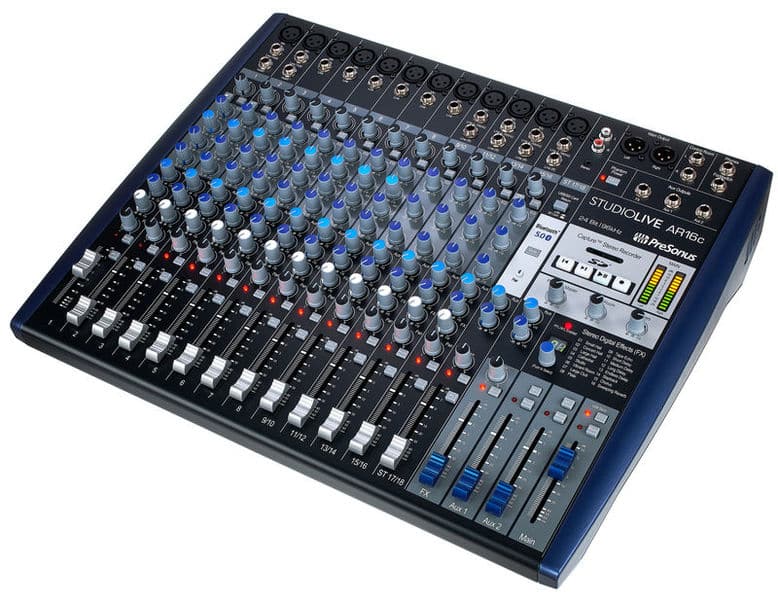
The StudioLive ARc series by Presonus offer a wide selection of mixing desks ranging from 8 tracks all the way up to 18, and all of them are capable of Multi-track recording, sending every Input to your DAW plus the Main mix channels.
These mixers have a nice feature that they call the “super channel”, which basically gives you all the inputs on one channel that you could possibly need; RCA (for CD and DVD players), a 1/8” mini jack (for plugging in your phone, tablet, etc.) and even Bluetooth to pair the mixer with your phone, tablet, laptop, etc.
One other benefit of the Presonus StudioLive ARc Mixers is that they can record directly to an SD card (the stereo mix only), negating the need for a computer when recording live.
Channels 1 and 2 have high-impedance inputs for instruments, such as electric guitars and basses.
The Presonus Studiolive ARc mixers provide you with 16 high-quality effects, which include reverb (room, hall and plate), chorus, delay, and more.
All of these Mixers can record up to 24-bit/96kHz and you also get a 48v Phantom Power control switch which enables it globally.
Included Software
- Studio One artist Edition (Presonus DAW) and Studio Magic Plug-in Suite for Mac and Windows, which includes seven Plugins in VST, AU and AAX formats.
The StudioLive AR mixers are definitely a great investment for a Home Studio, especially if you need to record a vast number of simultaneous inputs, or if you need a board that can be used both live and in the Studio.
Find out more about the PreSonus StudioLive ARc series here:
- StudioLive AR8c: Amazon, Sweetwater.
- StudioLive AR12c: Amazon, Sweetwater.
- StudioLive AR16c : Amazon, Sweetwater.
Zoom Livetrak L-12
The Zoom LiveTrak L-12 will allow you to record up to fourteen individual tracks to your DAW (12 inputs plus the Master Out) or to an SD card.
The first 8 tracks feature XLR/TRS inputs, with the first two having a Hi-Z instrument level input for electric guitars and basses.
The remaining six feature a PAD, which allows you to reduce the incoming level by 26dB when recording loud sources.
The last two channels are stereo inputs which can be on ¼” TRS jacks or RCA connectors.
The Zoom Livetrak L-12 can also be used for overdubbing, either in the DAW or internally, and the maximum recording quality of this mixer is 24-bit/96kHz.
The biggest difference between the LiveTrak mixers and all the other ones on this list is that it provides 5 headphone outputs, which can be used to create different mixes for every musician that is recording.
Each of the mono inputs (channels 1-8) include a one knob compressor and a 3-band EQ with sweepable mids. You can choose from a variety of effects to add to the tracks while also being able to add a Low-cut. Every channel also has a pan knob.
Each channel strip can operate in three different modes;
Audio Interface mode; The L-12 transforms into a 14-in/4-out USB interface for your device with flexible routing options.
USB mode: You can transfer projects and files to a connected drive.
Card Reader mode: Allows you to transfer files to and from your computer.
What’s even better is that you can record to the SD card and PC simultaneously, to use one of those as a backup, should you need it.
Lastly, the L-12 has the auto record feature, which will basically start recording as soon as it detects a certain dB level.
Find out more about the Zoom LiveTrak L12 & L-20 here:
- Zoom LiveTrak L-12: Amazon, Sweetwater.
- Zoom LiveTrak L-20: Amazon, Sweetwater.
It does everything you need it to do, be it recording a live band, rehearsals, or even just for doing some solo home recording, this mixer will do everything while still being very easy to use and intuitive.
If Mixers are a bit overkill for your needs, then here is an article I wrote about the best Audio Interfaces under $300.
Behringer X-Air XR18
The Behringer XR18 is a digital mixer that features a 18-in/18-out USB audio interface, and what’s even cooler is that it’s completely wireless.
16 of the inputs are XLR/TRS combo Jacks which feature their famous MIDAS preamps, and an additional two line inputs, as well as MIDI I/O.
The quality of these preamps is very good, providing you with an excellent signal-to-noise ratio and good headroom.
It also comes with 6 aux outputs which can be used to create headphone mixes, or for live monitoring, as well as a headphone output.
Lastly, it comes with the “Ultranet” port which connects to the Behringer’s P16 monitor distribution system and allows every musician to create their own headphone mix or their own monitor mix on stage.
As you can see it doesn’t provide any knobs or faders like most consoles, so how do you actually control it?
It can be controlled via Wi-Fi or ethernet using an Andrioid or iOS device by using the X-Air App which not only gives you an overview of what’s going on in the mixer, but it also works very similar to a DAW and comes included with loads of features and effects.
It even has an Auto-Mix feature that can manage fully automated mixes with up to 16 live microphones. However, this feature is not really intended for mixing live music, but rather conferences.
When it comes to cost-efficiency, the Behringer XR18 offers some of the best value, and this is certainly due to the fact that it doesn’t require as many onboard hardware controls, like faders and knobs, since it’s designed to work wirelessly.
Find out more about the Behringer X-Air XR18 here:
- Behringer X-Air XR18: Amazon, Sweetwater.
Additionally, I wrote a post about the best wireless mixers that you can check out here.
Soundcraft Signature MTK
The Signature MTK 12 and 22 series from Soundcraft are analog mixers that also come with onboard effects and USB multi-track recording and playback capabilities, and they both allow for 12 or 22 multi-track recording respectively.
It is important to make the distinction between the MTK series and the regular Series;
Both can be connected to the PC via USB but the regular ones can only record the stereo out and support 24-bit/192kHz resolution, while the MTK ones offer 12 or 22 Multi-track recording but at a reduced 24-bit/48kHz sample rate.
The MTK series are fantastic for anyone who is building a home studio and wants a good Mixer with loads of inputs and extra features.
The Ghost preamps featured on these consoles are considered top of the line and are of extremely high quality, giving you a lot of headroom, wide dynamic range and good signal to noise ratio.
These Mixers feature the Sapphyre Asymmetric EQ, which has two separate mid-bands, and offer Hi-Z inputs for electric guitars and basses.
Additionally, they come loaded with studio-quality effects from Lexicon like Reverb, Delay, Chorus, Modulation and other effects and DBX limiters on the input channels, as well as a 48v Phantom Power control, which is global, and also a High-Pass filter (for all mono inputs).
However, what I like the most about these mixers is that they are designed to be used for Hybrid mixing, which means that once you have all the tracks setup in your DAW, you can use the Mixer to mix them, add effects, etc.
Included Software
- Free downloads of the Lexicon MPXL native plug-in and Ableton Live 9 Lite.
The Soundcraft Signature MTK 12 and 22 Series are simple and easy to use, the recording quality is extremely good and they will serve you well either for live performances or for your home studio.
Find out more about the Soundcraft Signature MTK Series here:
- Soundcraft Signature MTK 12: Amazon, Sweetwater.
- Soundcraft Signature MTK 22: Amazon, Sweetwater.
Behringer X32 Producer
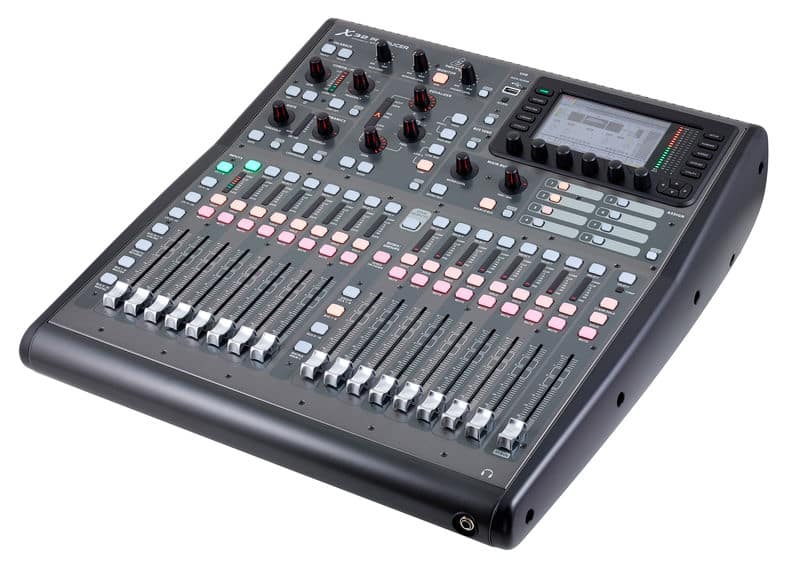
The Behringer X32 Producer edition is a 40-Input, 25-Bus Rack-Mountable Digital Mixing Console with 16 Programmable Midas Preamps, 17 Motorized Faders, 32-Channel Audio Interface and iPad/iPhone Remote Control.
It features a total of 16 XLR mic/Line inputs, 8 stereo FX returns, 16 mix buses, 8 XLR Outputs, 6 AUX I/O, and more, as well as a 32×32 Audio Interface, which means that you will be able to record up to 32 simultaneous tracks to your DAW separately.
Just like the Behringer XR18, this one comes with the “Ultranet” port which connects to the Behringer’s P16 monitor distribution system and allows every musician to create their own headphone mix or their own monitor mix on stage.
Sadly, it doesn’t provide any Hi-Z inputs for connecting guitars, basses, etc. directly to the board.
Additionally, it can be wirelessly controlled when connected to an iPad.
Lastly, and this will probably excite you about this mixer, it allows you to control the DAW with it, thanks to having motorized faders.
This means that most of the mixing can be done on the board itself, offering a much more “hands-on” approach.
Learn more about the Behringer X32 Producer here:
- Behringer X32 Producer: Amazon, Sweetwater.
Mackie DL16S
The Mackie DL16S is a wireless digital mixer that features a 16-in/16-out audio interface.
All of the inputs come with the Onyx+ preamps that should provide you with a lot of headroom and a great signal-to-noise ratio.
The Mackie DL16S is a wireless mixer, meaning that it has to be controlled wirelessly with an iPod, PC or Android device.
One clear advantage of wireless mixers is that every musician can connect to the mixer during a live show using their smartphones and control their own monitor/headphone mix without bothering the engineer.
Out of the 16 inputs, 8 are XLR only and the other 8 are XRL/TRS combo jacks, and it also provides 8 XLR outputs.
On top of that, you get 13 output buses, 6 stereo-linkable aux sends, 6 stereo-linkable subgroups, a Main L/R bus, and a headphone output.
Not only that but it comes with a router directly built-in, which allows you to connect up to 20 simultaneous devices.
Now, how do you control it, since it doesn’t have any knobs, faders, or any kind of channel strips?
It comes with the Master Fader Control App which can be used on any device such as iPod, PC, Android device, etc.
What this means is that you can set the mixer up on stage and control it from anywhere you’d like.
Same goes for your home studio, since you can set it up in a way where it’s completely out of the way, and then all you need to do is use the app to control it.
The App itself is like a DAW which comes with a lot of plugins and effects.
All in all, I think that the Mackie DL16S is a great mixer that works great both in live- and home studio scenarios.
Learn more about the Mackie DL16S here:
- Mackie DL16S: Amazon, Sweetwater.
Tascam Model 12, 16, and 24
The Tascam Model 12, 16 and 24 are true hybrid mixers that have all the controls an analog console has to offer, as well as some extra digital features.
They can record 8, 12, and 22 simultaneous tracks directly to your DAW or to an SD card at a maximum quality of 24-bit/48kHz.
On the first two channels you get an Instrument/Line-in jack with the ability to switch between them with the press of a button. Also, those two channels have an extra insert on the front.
They all can record either to your DAW or to an SD card, and also offer immediate playback of the tracks you recorded to the SD card.
Just like the Presonus StudioLive AR series, the Tascam Model Series come with RCA, minijack and Bluetooth connectivity for streaming Audio, and they even provide 16 built-in effects such as Reverb, Chorus, Delay, Flanger, etc.
The Phantom Power can be supplied globally, sadly not individually, but this shouldn’t be that much of an issue.
One distinctive feature is the Routing Mode selector, which is common to all channels;
It allows you to assign the input of your choice, like the live incoming signal, the return from a DAW channel or the return from the internal multitrack recorder to each channel for EQ, processing, etc.
This enables you to overdub in the studio or to play backing tracks, etc.
Additionally, they come with a 3-band EQ with Sweepable mids, plus a low-cut on those same channels. On the rest of them you only get a regular 3-band EQ plus the low-cut.
A stereo 7-band graphic EQ can be additionally applied to the main mix or monitors output, which lets you shape your mixes to your liking and prevent feedback.
Lastly, one feature unique to only the Tascam Model 12 is the DAW control Mode, which will transform the mixer into a control surface for all major DAWs.
The Tascam Model 12, 16 and 24 series are some of the best mixers you could get for your home studio, especially the Model 12 thanks to its built-in DAW control mode.
Learn more about the Tascam Model Series here:
- Tascam Model 12: Amazon, Sweetwater.
- Tascam Model 16: Amazon, Sweetwater.
- Tascam Model 24: Amazon, Sweetwater.
Mackie DL32R
The Mackie DL32R is a wireless digital rack-mounted mixer that features the Onyx+ preamps.
It has built in Wi-Fi so that you can connect it to your PC, iPad or Android Device, and control it using the Master Fader Control App.
The number of Ins and Outs on this mixer is just absurd, with 32 analog inputs divided into 24 XLR- and 8 XLR/TRS combo jacks, and 1 AES/EBU (XLR), 14 XLR (Assignable), 2 TRS (Monitor), and Headphone Outputs.
On the back it comes with the USB connector that allows you to connect it to a PC and to use it as an 32 -in/32-out Audio Interface, as well as a second USB connector to connect an additional USB hard drive.
This means that you could record directly to an external drive without needing a PC.
This mixer is both great for large recording studios as well as home studios, but where it excels at is live performances, because you can setup the mixer on the stage and control it from anywhere in the venue, not having to worry about the cables.
The Master Fader Control App is fantastic since it’s basically an entire premium DAW that comes with effects, compressors, EQs, and more, all of which can be used live.
Included Software
- Master Fader App
- Free Avid Downloads
If you are just building a small home studio, then I honestly believe that the Mackie DL32R is a bit overkill since you probably will never take advantage of the 32 channels.
However, if you’re looking to expand, or if you need a great mixer for live situations that will allow you to control the mix from anywhere in the room while also serving as a fantastic home studio mixer, then it might be a great choice!
Learn more about the Mackie DL32R here:
- Mackie DL32R: Amazon, Sweetwater.
Presonus StudioLive Series III
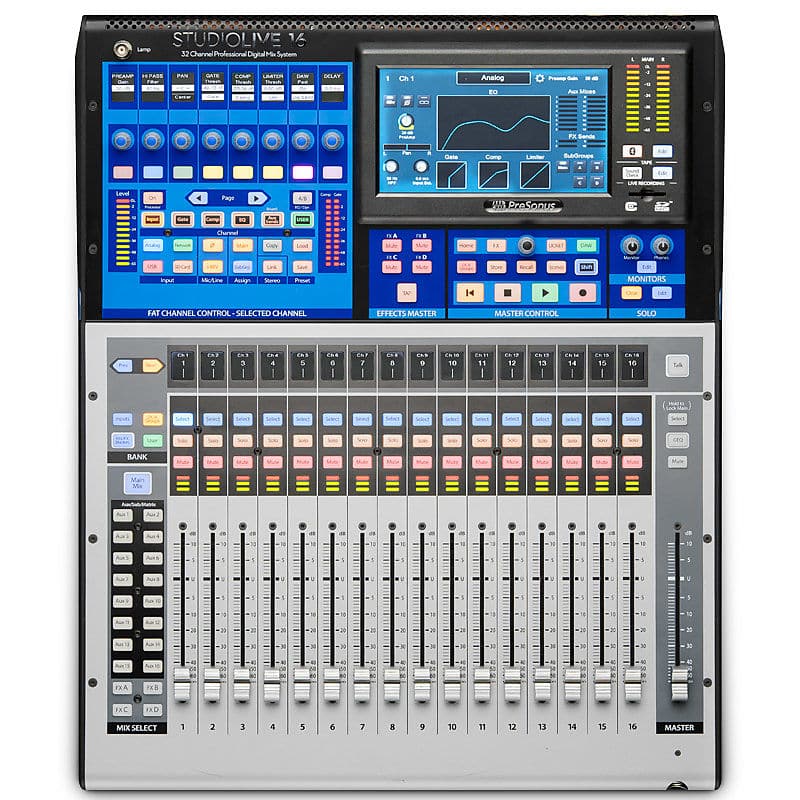
The StudioLive Series are the latest digital Presonus mixers and they range from 16 channels all the way up to 64.
These mixers are capable of multitrack recording and also feature the DAW control mode, which turns the mixers into a control surface for your DAW.
One feature of these mixers is the Fat channel, which is the section that delivers a compressor, limiter, gate/expander, and four-band parametric EQ on every input channel and the mix bus.
The Fat Channel features a touch screen and allows you to access different types of compressors, EQs, etc.
This gives you a lot of options and a simple and fast workflow, plus it also provides a highpass filter on every channel and aux bus and polarity invert for each input channel.
When recording, you can choose to record the audio with the effects you add to them or the RAW files, if you want to do all the processing in the box.
Motorized faders are also featured on these consoles and this is useful when linking two channels together and even for fader layering, creating different headphone mixes for every musician and recalling those with the press of a button, etc.
Lastly, with the purchase of a StudioLive mixer you get Studio One Artist included, and one interesting feature of using the mixer with the Studio One software is that you can import the settings of the plugins on the Fat Channel directly into the DAW with the press of a button.
This means that if you had a great-sounding mix going, you don’t have to start from scratch on the PC, just one click and all the settings will be moved over to the DAW.
Learn more about the Presonus StudioLive series III mixers here:
- StudioLive 16: Reverb.
- StudioLive 32: Amazon, Thomann, Sweetwater.
Behringer Wing
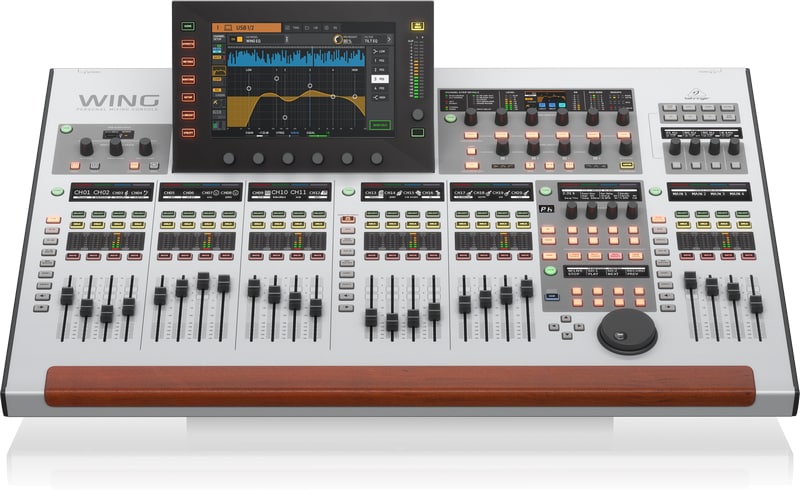
The Behringer Wing is a digital console that features 48 channels (mono, stereo or Mid/Side compatible), 16 buses, 8 matrix buses and 4 main buses.
Everything on this console is configurable; from the way the channels are laid out, to the routing of the signals and even the lighting of the console itself.
It features a touchscreen where you can monitor what is going on as well as access all the controls to configure literally everything.
The channel count can be increased to up to 144 by connecting stageboxes to the three AES50 ports, which is huge!
Just like the previous digital consoles on this list, the Behringer Wing can be accessed remotely via an App, giving you the ability to control everything directly from the stage as well as letting the musicians manage their own headphone mixes.
One feature that is unique to this console is the 32-channel StageCONNECT interface for personal monitoring or analog I/O boxes, which is ideal if you’re using external in-ear monitor transmitters, for example, since you can route them out using a single XLR cable into a breakout box.
Not only can you do multitrack recording to your DAW with this mixer, but also up to 64-track recordings on-to an SD card.
Lastly, it features 16 true-stereo processors with effects, High-Pass Filter, Tilt EQ and much more.
Learn more about the Behringer Wing here:
- Behringer Wing: Amazon, Thomann, Sweetwater.
Conclusion
I know that all these mixers are quite different, especially when looking at their price tag.
However, they are all excellent, but you should really know which one to buy depending on your needs.
If you’re a beginner and are looking for a small mixer, then go with either the Allen & Heath ZEDi 10FX or with the Presonus StudioLive AR8c.
If you need something bigger just look at the channel count and go from there.
If you just want to go all out and get one of the best overall mixers available, then the StudioLive 16 Mixers are the way to go.
I hope this information was useful!
Have a wonderful day!
